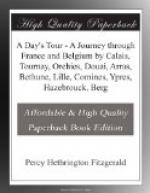Dunkirk, a fortress of the ‘first class,’ fortified on the modern system, and therefore to the careless spectator scarcely appearing to be fortified at all—is a place of such extreme platitude, that the belated wayfarer longs to escape almost as soon as he arrives. There is literally nothing to be seen. But a few miles away, there is to be found a place which will indemnify the disgusted traveller, viz., BERGUES. As the train slackens speed I begin to take note of rich green banks with abundant trees planted in files, such as Uncle Toby would have relished in his garden. There is the sound as of passing over a military bridge, with other tokens of the fortified town. There it lies—close to the station, while the invariable belfry and heavy church rise from the centre, in friendly companionship. I have noted the air of sadness in these lone, lorn monuments, which perhaps arises from the sense of their vast age and all they have looked down upon. Men and women, and houses, dynasties and invaders, and burgomasters, have all passed away in endless succession; but they remain, and have borne the buffetings of storms and gales and wars and tumults. As we turn out of the station, a small avenue lined with trees leads straight to the entrance. The bright snowy-looking place basks in the setting sun, while the tops of the red-tiled roofs seem to peep at us over the walls. At the end of the avenue the sturdy gateway greets us cheerfully, labelled ‘Porte de Biene,’ flanked by two short and burly towers that rise out of the water; while right and left, the old brick walls, red and rusted, stretch away, flanked by corner towers. The moat runs round the whole, filled with the usual stagnant water. I enter, and then see what a tiny compact little place it is—a perfect miniature town with many streets, one running round the walls; all the houses sound and compact and no higher than two stories, so as to keep snug and sheltered under the walls, and not draw the enemy’s fire. The whole seems to be about the size of the Green Park at home, and you can walk right across, from gate to gate, in about three minutes. It is bright, and clean ‘as a new pin,’ and there are red-legged soldiers drumming and otherwise employed.
Almost at once we come on the place, and here we are rewarded with something that is worth travelling even from Dover to see. There stands the old church, grim, rusted, and weather-beaten, rising in gloomy pride, huge enough to serve a great town; while facing it is the belfry before alluded to, one of the most elegant, coquettish, and original of these always interesting structures. The amateur of Flemish architecture is ever prepared for something pleasing in this direction, for the variety of the belfries is infinite; but this specimen fills one with special delight. It rises to a great height in the usual square tower-shape, but at each corner is flanked by a quaint, old-fashioned tourelle or towerlet, while in the centre is an airy elegant lantern of wood, where a musical peal of bells, hung in rows, chimes all day long in a most melodious way. Each of these towerlets is capped by a long, graceful peak or minaret. This elegant structure has always been justly admired by the architect, and in the wonderful folio of etchings by Coney, done more than fifty years ago, will be found a picturesque and accurate sketch.




